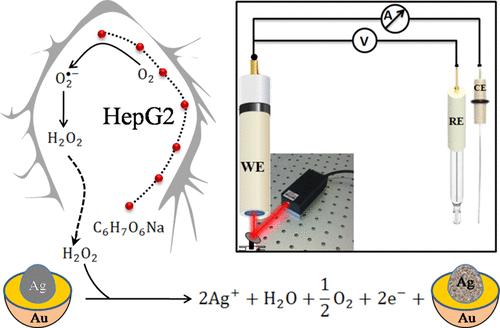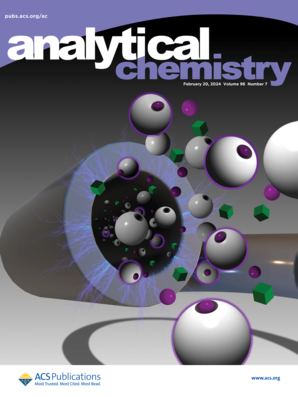Core-to-Shell Thickness-Regulated Ag@Au Nanocatalyst for LSPR-Improved In Situ Detection of Extracellular Peroxide: Response in a Cancer Cell
IF 6.7
1区 化学
Q1 CHEMISTRY, ANALYTICAL
引用次数: 0
Abstract
In the current study, we designed a unique core-to-shell thickness-regulated Ag@Au nanocatalyst (CSNPs) for H2O2-induced selective oxidative etching of core silver. Synthesized CSNPs exhibit high colloidal stability and demonstrate a significant localized surface plasmon resonance (LSPR) effect in the biological window. These unique properties in turn allow us to formulate a unique CSNP-based LSPR-induced electrochemical detection assay for selective trace-level sensing of H2O2 in vitro. Conceptually, we utilized LSPR to amplify the electrochemical signals by inducing the generation of hot electrons and hot holes, which can be harnessed for catalytic purposes. Here, the Au shell acts as a supplier of the hot electron for enhanced catalytic reduction of H2O2 where the free electron of the Au shell is subsidized by the Ag core by its subsequent oxidation. The combination of high LSPR property, stability, and efficient binding property makes these NPs not only a surface-enhanced Raman scattering (SERS) enhancer but also a promising electrocatalyst for biomolecule detection, which emphasizes the significant potential of these engineered nanomaterials in various applications.

用于 LSPR 改进型细胞外过氧化物原位检测的核-壳厚度调节 Ag@Au 纳米催化剂:癌细胞中的反应
本文章由计算机程序翻译,如有差异,请以英文原文为准。
求助全文
约1分钟内获得全文
求助全文
来源期刊

Analytical Chemistry
化学-分析化学
CiteScore
12.10
自引率
12.20%
发文量
1949
审稿时长
1.4 months
期刊介绍:
Analytical Chemistry, a peer-reviewed research journal, focuses on disseminating new and original knowledge across all branches of analytical chemistry. Fundamental articles may explore general principles of chemical measurement science and need not directly address existing or potential analytical methodology. They can be entirely theoretical or report experimental results. Contributions may cover various phases of analytical operations, including sampling, bioanalysis, electrochemistry, mass spectrometry, microscale and nanoscale systems, environmental analysis, separations, spectroscopy, chemical reactions and selectivity, instrumentation, imaging, surface analysis, and data processing. Papers discussing known analytical methods should present a significant, original application of the method, a notable improvement, or results on an important analyte.
 求助内容:
求助内容: 应助结果提醒方式:
应助结果提醒方式:


